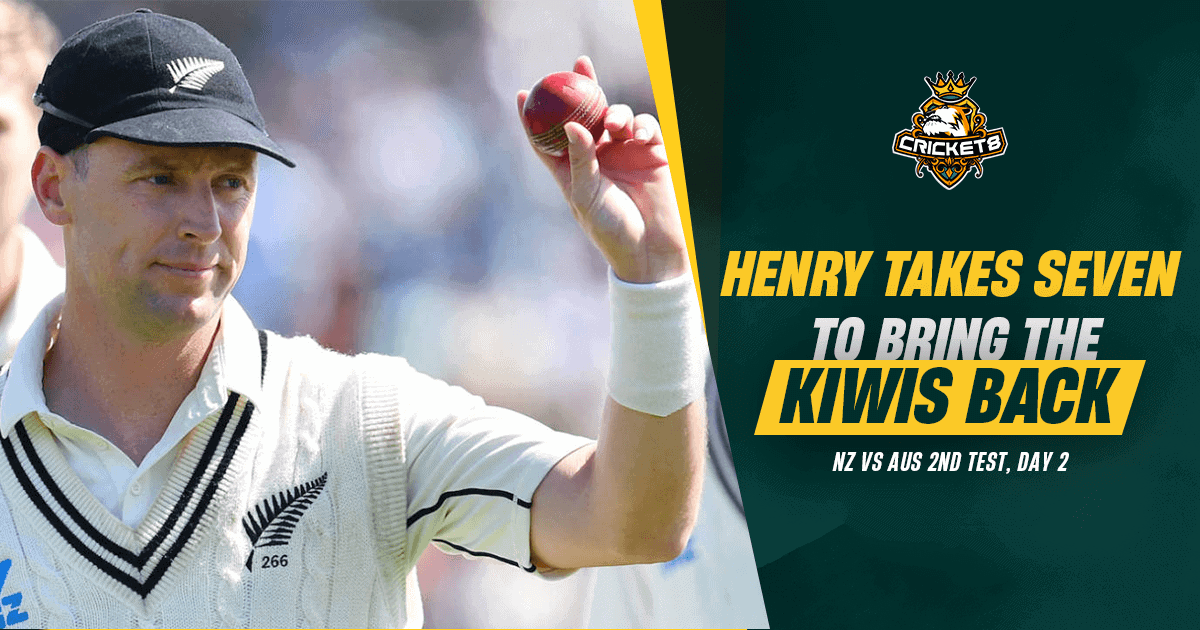Matt Henry’s wonderful bowling spell took New Zealand straight back in the contest as the pace bowler took seven wickets in the first innings. This display ensured the Australians would be within touching distance of the hosts despite Marnus Labuschange’s heroics with the bat. Labuschagne just missed out on another Test century but batted with verve and courage during his stay at the crease. Tom Latham also exuded assurance when he guided his side to slender lead in the afternoon session.
Team Lineups
Australia has fielded an unchanged side for the second time in this series. Steve Smith is still settling in his opening berth after the retirement of David Warner. Cameron Green finally justified his number four position in the batting order with a match winning performance in the first Test match at Basin Reserve. Marnus Labuschage and Alex Carey have recently come under heavy criticism after their constant failures with the bat. Travis Head is also underperforming with the bat since his heroics in the World Cup final.
The fabulous four in bowling with the pace trio of Patrick Cummins, Mitchell Starc and Josh Hazlewood looks settled as ever. These three bowlers offer different options for the captain Cummins throughout the game. Nathan Lyon is constantly moving towards new records having secured another ten-wicket haul in the last match.
New Zealand created history by defeating a South African side in a Test series for the first time in their history. However, their performances have been well below par in this series. They have made one change to their team that was comprehensively beaten in the last Test match at Basin Reserve. Will O”Rourke made way for Ben Sears who made his debut in the Test format. The New Zealand batting department failed miserably in the first Test match with Tom Latham enduring a bad patch in his career. Kane Williamson failed in both innings when the Kiwis needed their talismanic batsman to perform. Daryl Mitchell also struggled to play shots regularly in the first Test.
Rachin Ravindra was the exception by posting a memorable century in the first Test match. Tim Southee is yet to find the best form of his series. Scott Kuggeleijn’s inclusion in the team has sparked debuts throughout the cricketing community, but the 32 year old was selected for the second game running. Matt Henry was the pick of the bowlers for the New Zealanders in the first game and Kiwi captain would depend on this brilliant bowler to deliver early breakthroughs.
New Zealand
- Tom Latham 2. Will Young 3. Kane Williamson 4. Rachin Ravindra 5. Daryl Mitchell 6. Tom Blundell (WK) 7. Glenn Phillps 8. Scott Kuggeleijn 9. Matt Henry 10. Tim Southee (Cap.) 11. Ben Sears
Australia
1. Usman Khawaja 2. Steve Smith 3. Marnus Labuschagne 4. Cameron Green 5. Travis Head 6. Mitchell Marsh 7. Alex Carey (WK) 8. Mitchell Starc 9. Pat Cummins (Cap.) 10. Nathan Lyon 11. Josh Hazlewood
Australian captain Patrick Cummins won the toss and sent the Kiwis to bat first. The Hagley Oval pitch in Christchurch usually offers a pacer friendly track. The greenish top would allow the pace bowlers to use the new ball to get some swing. The pitch also enables the bowlers to get enough bounce off the surface. However, it is tough to predict the nature of the pitch at Hagley Oval. In the last three years, the highest team total, highest successful run chase and lowest team total records have been broken at this venue.
The fast bowlers and the batters may receive assistance from this surface. The average first innings score is 320 at this ground. The teams that have fielded first have secured seven wins at this ground. So, the captain winning the toss would be tempted to bowl first under the favourable conditions.
The playing surface was assisting the pace bowlers by letting them generate bounce and movement. The carry to the wicketkeeper is also fine in terms of the pace. But on the third day, the pitch may help the batters as the balls would come to bat more easily. Pat Cummins would look to up the ante by deploying a world class pace attack against the Kiwi batters who have struggled throughout the series.
Fixture
The historic Trans-Tasman rivalry between Australia and New Zealand is poised to reignite in a thrilling showdown as they gear up for the inaugural Test of the highly anticipated two-match series commencing on February 29th (Thursday), vying for the prestigious Chappell-Hadlee Trophy.
Australia is embarking on a momentous red-ball tour of their neighbouring arch-rivals for the first time since the memorable encounters of February 2016. Back then, Australia asserted their dominance emphatically, clinching a commanding 2-0 triumph over the Kiwis.
The Aussies undeniably hold the upper hand over the Blackcaps in the traditional red-ball format, boasting a stellar record with 35 victories out of the 61 Tests contested, while New Zealand has mustered only eight wins, with 18 matches culminating in a stalemate.

Armed with the aura of reigning champions of the World Test Championship, Australia strides into the series brimming with confidence following their recent resounding success in the T20I series, where they outclassed New Zealand with a clinical 3-0 whitewash. Nonetheless, New Zealand draws inspiration from their commendable performance against a makeshift South African squad in the recent two-match Test series.
Offering a sneak peek into the battlefield, the Hagley Oval in Christchurch unveils a pitch shrouded in a lush green cover for the impending contest. The verdant hue promises to favour the seamers from both camps, potentially posing a formidable challenge for the team tasked with setting the tone in the opening innings. Notably, the historic venue has witnessed outcomes in 11 out of the 12 Tests held within its precincts, with a remarkable 7 of those victories belonging to sides that opted to unleash their bowling arsenal first.
With the promise of moisture-laden conditions and the allure of fresh grass blades, the bowlers entrusted with embarking on this cricketing odyssey stand poised to exploit the early advantage offered by the Hagley Oval wicket, setting the stage for a compelling battle between bat and ball
| Venue | The second day of the first Test match between Australia and New Zealand was played at The Hagley Oval, Christchurch, New Zealand. |
| Date | The second day started on Saturday, March 9, 2024, at 10:00 a.m. local time. |
Captaincy & Tactics
The second day of the second Test between New Zealand and Australia was a rollercoaster ride, with the Black Caps clawing their way back into contention after a dominant first innings display by the tourists. Marnus Labuschagne, poised for a well-deserved century, was denied by a sensational catch just before lunch, leaving Australia with a healthy but not insurmountable lead.
Labuschagne, desperate to end his run of low scores, batted with grit and determination. He anchored the Australian innings, his almost four-hour vigil offering much-needed stability. However, just ten runs shy of a landmark century, fate intervened. A blinder of a catch by Glenn Phillips at gully, a full-length diving effort that defied gravity, snatched away Labuschagne’s dream and left him devastated. This dismissal proved pivotal, ensuring New Zealand kept the deficit under 100 runs.
Matt Henry, the hero of the day for the Black Caps, ripped through the Australian top order. His fiery spell of 7-67 was the best bowling performance by a New Zealander against Australia since Sir Richard Hadlee’s legendary feat in 1985. This exposed Australia’s batting frailties once again, with their top six succumbing for a combined score below 200 for the sixth consecutive innings.
Despite their second-day resurgence, the weight of history sits heavily on the Black Caps’ shoulders. They haven’t secured a Test win over Australia on home soil since 1993, and their last victory in Christchurch came a staggering 50 years ago.
The pitch at Hagley Oval proved to be a double-edged sword. The lively surface that aided Australia’s first innings dominance had calmed down considerably by the time New Zealand started batting. This unexpected change in character threw a curveball at both teams’ strategies.

Australia, while dominant in patches, were let down by dropped catches. Nightwatchman Nathan Lyon’s early dismissal could have been avoided if Daryl Mitchell had held onto a straightforward chance at first slip. These missed opportunities could prove costly in the long run.
In a bid to counter the swing and seam of the New Zealand seamers, Labuschagne adopted an unorthodox approach. He ventured well outside his crease and walked further down the pitch after each shot. This tactic caught the attention of the umpires, who warned him against wandering into the “danger area” in front of the stumps. Interestingly, it was only after the wicketkeeper moved closer to the stumps that Labuschagne was forced to modify his stance, a factor that arguably contributed to his dismissal.
Alex Carey, Australia’s wicketkeeper-batsman, continued his struggles with the bat. After falling for low scores in the first Test, he succumbed to a similar dismissal in the second innings. His dismissal to fellow wicketkeeper-turned-bowler Glenn Phillips put further pressure on the Australian lower order.
Pat Cummins, ever the warrior, offered a brief glimmer of hope for Australia with a scintillating counter-attack. He smashed boundaries and a six off consecutive deliveries from debutant Ben Sears. However, his resistance was short-lived as he fell victim to Matt Henry, leaving Australia with a precarious lead.
The stage is set for a thrilling third day. Can New Zealand pull off a historic win, or will Australia find a way to extend their lead and tighten their grip on the match?
With a lively pitch offering assistance to both seam and swing bowling, the outcome of the Test remains uncertain. Australia will look to build on Labuschagne’s knock and establish a first innings lead. New Zealand, on the other hand, will need their bowlers to replicate their day one performance and restrict the visitors’ scoring.
Batting Analysis
The second day of the second Test between New Zealand and Australia was a day of redemption for Kane Williamson. After a disappointing first innings that saw him dismissed for just 17, Williamson rose to the occasion in his 100th Test, delivering a fighting half-century that reignited the Black Caps’ hopes.
The Hagley Oval faithful had come prepared to celebrate Williamson’s milestone. From the moment he strode to the crease on Friday, a standing ovation erupted, a testament to the immense respect he commands. However, his first innings contribution fell short of the fairytale script the fans envisioned.
Undeterred, Williamson returned on Saturday with a clear purpose. He dug in deep, patiently constructing his innings alongside Tom Latham. Their 105-run partnership for the second wicket not only erased Australia’s first-innings lead of 94 but also injected a much-needed dose of stability into the New Zealand batting.
Williamson’s knock, a 34th Test fifty meticulously compiled off 105 balls, was a masterclass in resilience. He weathered the early storm posed by the potent Australian bowling attack, finding boundaries with well-timed shots and expertly navigating the tricky Hagley Oval surface. The crowd, a vibrant mix of New Zealanders and Australians united in their appreciation for the game, erupted with every Williamson boundary, the applause echoing around the stadium.

The atmosphere was truly electric. Fans, some dressed in elaborate costumes for the designated “dress-up day,” had transformed Hagley Oval into a sea of color and noise. The occasion transcended national allegiances, with the entire stadium rising as one to acknowledge Williamson’s well-deserved milestone – his 50th run in his 100th Test.
Williamson’s dismissal later in the day, caught lbw by Pat Cummins, brought a hush to the crowd. Yet, he departed with his head held high, having played a pivotal role in shifting the momentum back in New Zealand’s favor.
Latham, meanwhile, continued his fine form, reaching his highest Test score against Australia – an unbeaten 65. The stage is now set for a thrilling third day, with New Zealand holding a slender lead and Latham and Rachin Ravindra at the crease. Can the Black Caps build on Williamson’s foundation and secure a historic victory in his landmark Test, or will Australia find a way to wrest back control?
Bowling Analysis
Kane Williamson delighted fans on the second day of the second test match between New Zealand and Australia by showcasing his resilience and skill with a hard-fought half-century in his 100th test appearance. Despite a disappointing first innings, Williamson shone in the second innings, crafting his 34th test half century from 105 deliveries in a crucial 105-run partnership with Tom Latham.
Together, the duo orchestrated a remarkable turnaround for New Zealand, steering the team from a precarious position of 6-1 to a more promising 111-2, effectively wiping out Australia’s first innings lead of 94 runs. By the time Williamson departed for 51, New Zealand had reached 134-2, holding a narrow 40-run lead over the visitors. Latham remained unbeaten on a solid 65, his highest test score against Australia, while Rachin Ravindra contributed 11 runs to the total.
After the day’s play, Williamson acknowledged the challenge posed by Australia’s quality bowlers and the tricky pitch conditions, expressing optimism for extending their partnership further in the upcoming day. He praised Latham for his commanding performance and elegant stroke play, leading the way with his bat.

Hagley Oval witnessed a sense of reverence and celebration as both Williamson and New Zealand captain Tim Southee marked their 100th test appearances, drawing admiration and accolades from the spectators. Despite a modest score in the first innings, Williamson received a heartfelt standing ovation from the crowd, setting the stage for his impactful contribution in the second innings.
Both teams engaged in a gripping battle throughout the day, with Marnus Labuschagne showcasing his form with a crucial knock of 90 for Australia, while Matt Henry’s exceptional bowling display kept New Zealand in contention. The atmosphere at the stadium was electrifying, with fans from both sides cheering on their teams with fervor.
As the match hangs in balance, the performances of key players like Williamson, Latham, and Labuschagne are pivotal in determining the outcome of the test. The stage is set for an exciting continuation of the contest as both teams strive for supremacy on the field.
Fielding Performance
One of the major differences between the two sides has been in the fielding department. The Australian fielding performance was immaculate in the first Test match, whereas the Kiwis have come up short in this department. On the first day of the second Test match, The Australians continued to impress with their fielding. They took all of their chances except two of the chances that fell to the usual brilliant Cameron Green and Travis Head. Alex Carey was the star of the show for the Australians by taking five catches in the innings. Among them, there were two magnificent catches to send Daryl Mitchell and Glenn Phillips back to the pavilion. Apart from his destruction with the ball, Josh Hazlewood took a fine catch to put an end to Tim Southee’s rearguard action. Usman Khawaja took a sharp catch at first slip to dismiss Rachin Ravindra early in the game. But the best catch of the day belonged to the mercurial all-rounder Mitchell Marsh. The ball flew towards him at a fast pace where he reacted late but sharply to complete a stunning catch that dismissed Will Young.
Key Performances
Matt Henry had a phenomenal performance, claiming a seven-wicket haul to restrict Australia in the second Test at Hagley Oval. Tom Latham and Kane Williamson then led a stirring fightback for New Zealand, with Latham scoring an unbeaten 65 and Williamson contributing 51 before falling to Pat Cummins’ deceptive delivery.
Towards the end of day two, just before stumps, Latham got a lucky break as he edged a delivery from Josh Hazlewood, but wicketkeeper Alex Carey couldn’t hold onto the catch after diving low in front of Usman Khawaja at slip. Despite this opportunity, Latham and Rachin Ravindra managed to build a solid partnership, with New Zealand holding a 40-run lead.
The pitch seemed to flatten out during the match, but there was still movement for the seamers to exploit. Australia used a variety of bowlers, with Cummins and Hazlewood looking particularly threatening.
Williamson, in his 100th Test match, played elegantly and reached his half-century off 105 balls, showcasing his determination after struggling earlier in the series. However, he was dismissed by Cummins just when he seemed set for a bigger score.
Cummins, relatively quiet in the series prior to this spell, produced a hostile performance late in the day. Despite the pressure, Latham and Ravindra stood firm to continue New Zealand’s resurgence after their low first innings total.
Earlier in the day, Henry’s exceptional bowling display restricted Australia to 256, with his figures of 7 for 67 being the second best by a New Zealand bowler against Australia. The Australian batting order struggled once again, with Labuschagne being the standout with a well-anchored 90 runs.
Labuschagne, who had experienced a form slump, showed improved performance after dedicated work in the lead-up to the match. However, his bid for a century was cut short by a spectacular catch from Glenn Phillips at gully.
Turning Point
The turning point of the day came at the final ball of the 32 over of the New Zealand innings. The New Zealanders were already in trouble with Josh Hazlewood and Mitchell Starc ripping through their top order. They lost four wickets at a score of 74. Kane Willaimson was at the crease, playing his 100th Test match. The New Zealand legend had a first Test match but looked to be at ease in this innings.
Williamson was playing at a score of 17 from 36 balls. Josh Hazlewood delivered a dream ball to breach through the defences of Williamson. The ball pitched full on middle and got past Willamson’s bat with a slightly inward shape. Willamson played down the wrong line and was struck in the pad. There was no doubt in the umpire’s mind that it was a clear out. However, Williamson decided to take the review to no avail. The New Zealanders could not amass a good total after this blow and their innings ended well before reaching the 200 mark.
Day Result
New Zealand are 40 runs ahead after the completion of day two at Christchurch. The Kiwis have eight wickets in hand to increase the lead. Tom Latham is batting at a score of 65 at the end of day’s play.
Brief Scorecard
| New Zealand First Innings: 162/10 (45.2 overs) | Australia First Innings: 256/10 (68 overs) | New Zealand Second Innings: 134/2 (50 overs) |
| Tom Latham 38 (69) | Marnus Labuschagne 90 (147) | Tom Latham 65* (154) |
| Matt Henry 29 (28) | Mitchell Starc 28 (54) | Kane Williamson 51 (107) |
| Josh Hazlewood 5/31 (13.2 overs) | Matt Henry 7/67 (23 overs) | Pat Cummins 1/21 (11 overs) |
| Mitchell Starc 3/59 (12 overs) | Glenn Phillps 1/14 ( 5 overs) | Mitchell Starc 1/39 (11 overs) |
Day Highlights
Day Wrap-Up
It was another action packed day at Christchurch with the bowling domination of Matt Henry grabbing the headlines. The right arm fast bowler picked up seven wickets in the innings to keep Australia within sight. In reply, Tom Latham has hit form just at the right time for the Kiwis with an authoritative innings with the bat. The hosts would look to post a lead pass 200 as they look to bring themselves back in the series.




